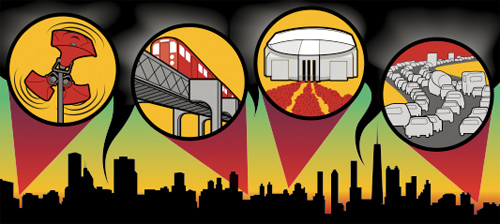Last fall, a national transportation group gave Chicago-and every other sizable U.S. city except Kansas City-a failing grade on their evacuation plans following major disasters (think massive storms or terrorist attacks). Another report issued in January by the Department of Homeland Security gave Chicago low marks on its level of cooperation and coordination among various emergency agencies. Both studies have been roundly challenged by various experts and city officials. Nonetheless, they got us thinking: What exactly is Chicago’s evacuation plan? Citing security concerns, the city’s Office of Emergency Management and Communications declined to discuss details; they did, however, let us peek at their emergency playbook.
by Sam Moulton
|
60
Percentage of downtown workers who use public transportation to commute, according to the Chicago Metropolitan Agency for Planning. |
3,000
Number of people who took part in Chicago’s voluntary mass evacuation drill last September. Chicago was the first major U.S. city to stage such an event. |
$4 million
Construction cost of the City Incident Center, one of two places under the city’s “Operation Virtual Shield” program, which lets officials monitor emergency situations in real time through a network of cameras. Chicago’s chief emergency officer, Cortez Trotter, would coordinate the 30 or so various agencies that could be involved in a disaster response. |
|
|
||
 |
|||
|
How will I know there’s an emergency? There are 112 sirens, located one to two miles apart, in Chicago’s Emergency Warning System. These can be activated individually, by zone, or citywide. A three-minute rising and falling tone indicates a major disaster or emergency; the all-clear signal is one continuous blast. [Other than 30-second tests the first Tuesday of each month at 10 a.m., the sirens were last sounded on September 22, 2006, as a tornado warning.] |
How long would it take to evacuate downtown? A CMAP technical evaluation indicated that in the best-case scenario, it would take two to three hours to evacuate the downtown Chicago area. That would mean transporting some 600,000 workers and 31,000 residents, not to mention an untold number of visitors, on an average weekday out of the city’s center. |
Where would people go? City hall has reportedly negotiated “disaster agreements” with the CTA, park district, and Chicago Public Schools, preemptively identifying dozens of designated mass-care facilities. The city won’t specify exact locations now but concedes that high-capacity facilities like McCormick Place and the United Center would likely be used. |
How would all those cars get out of the city? According to Joseph Schofer, a transportation expert and professor at Northwestern University, the city’s highway system can handle about 40,000 cars an hour. In addition, the city will install up to 80 manually operated, crash resistant barriers over the next few years. Designed to seal off inbound interstate lanes, the barriers could keep lanes free for rescue personnel, or open up lanes to outbound traffic in an evacuation. |
YOU SHOULD KNOW…
In case of a major evacuation or disaster, the city would activate its emergency information line, 877-745-INFO, for event-specific information such as road closures and areas to be evacuated (you can also call 311, the city’s nonemergency line). Visit www.alertchicago.com for comprehensive information on emergency preparedness in Chicago-and sign up for the city’s 911 call-back system, which can be used to deliver 30-second recorded messages and is capable of making 1,000 calls a minute.


